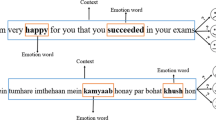Abstract
At present, convolutional neural network has achieved good results in text emotional classification, but in several common models, it does not make use of a large number of prior knowledge that human society has now acquired. This paper proposes a new CNN model based on emotional dictionary: emotional knowledge-CNN (EK-CNN), which uses emotional dictionary as additional knowledge to improve the performance of the model in emotional classification. The model has been validated on three real data sets, and is superior to the existing technology model for text emotion classification.
Access this chapter
Tax calculation will be finalised at checkout
Purchases are for personal use only
Similar content being viewed by others
References
Yujiao, L., Yan Shenggen, Wu., Shaomei, , et al.: Chinese text sentiment classification based on emotional dictionary and conjunctions. Journal of Sichuan University (Natural Science Edition) 52(01), 57–62 (2015)
Zhilin, Z., Chengqing, Z.: Study on Chinese Microblog Emotion Classification Based on Diversified Features. Journal of Chinese Information Processing 29(04), 134–143 (2015)
Pang Lei;Li Shoushan;Zhou Guodong: Chinese microblog emotion classification method based on emotion knowledge. Comput. Eng. 13, 156–158 (2012)
Lopez M M, Kalita J. Deep Learning applied to NLP. arXiv preprint arXiv:1703.03091, 2017.
R. Socher, A. Perelygin, J. Wu, J. Chuang, C. Manning, A. Ng, C. Potts. 2013. Recursive Deep Models for Semantic Compositionality Over a Sentiment Treebank. In Proceedings of EMNLP 2013.
Kim Y. Convolutional neural networks for sentence classification. arXiv preprint arXiv:1408.5882, 2014.
Linhong, Xu., Hongfei, L., Jing, Z.: Construction and Analysis of Emotional Corpus. Journal of Chinese Information Processing 22(1), 116–122 (2008)
Nasukawa T, Yi J. Sentiment analysis: Capturing favorability using natural language processing. Proceedings of the 2nd international conference on Knowledge capture. ACM, 2003: 70–77.
Mikolov T, Chen K, Corrado G, et al. Efficient Estimation of Word Representations in Vector Space. arXiv Preprint. arXiv: 1301.3781.
Mikolov T, Sutskever I, Chen K, et al. Distributed Representations of Words and Phrases and Their Compositionality. Proceedings of International Conference on Neural Information Processing Systems. 2013: 3111–3119.
Feng Shi, Fu., Yong-Chen, Y.F., et al.: Analysis of Emotional Tendency of Blog Post Based on Dependency Syntax. Computer Research and Development 49(11), 2395–2406 (2012)
Chen, T., Xu, R., He, Y., et al.: Improving sentiment analysis via sentence type classification using BILSTM-CRF and CNN. Expert System with Applications 72, 221–230 (2017)
Li H,Yu Q. The wire beltline diameter ACO-KF-PID control research. Prognostics and System Health Management Conference IEEE, 2017:1–6.
Chung J, Gulcehre C, Cho K H, et al. Empirical evaluation of gated recurrent neural networks on sequence modeling. arXiv preprint arXiv:1412.3555, 2014.
Luo, L., Yang, Z., Yang, P., et al.: An attention-based BiLSTM-CRF approach to document-level chemical named entity recognition. Bioinformatics 34(8), 1381–1388 (2017)
Fan Jiancong. OPE-HCA: an optimal probabilistic estimation approach for hierarchical clustering algorithm. Neural Computing & Applications, 31(7): 2095–2105.
Liu, X., Fan, J., Chen, Z.: Int. J. Mach. Learn. & Cyber. (2019). https://doi.org/10.1007/s13042-019-00993-8
Li Yang, Fan Jian-cong, Pan Jeng-Shyang, Mao Gui-han, Wu Geng-kun. A Novel Rough Fuzzy Clustering Algorithm with A New Similarity Measurement. Journal of Internet Technology, 20(4): 1145–1156.
Krizhevsky A, Sutskever I, Hinton G E. Imagenet classification with deep convolutional neural networks. Advances in neural information processing systems. 2012: 1097–1105.
Srivastava, N., Hinton, G., Krizhevsky, A., et al.: Dropout: a simple way to prevent neural networks from overfitting. the Journal of Machine Learning Research 15(1), 1929–1958 (2014)
Acknowledgements
We would like to thank the anonymous reviewers for their valuable comments and suggestions. This work is supported by Shandong Provincial Natural Science Foundation of China under Grant ZR2018MF009, ZR2019MF003, The State Key Research Development Program of China under Grant 2017YFC0804406, National Natural Science Foundation of China under Grant 91746104, the Special Funds of Taishan Scholars Construction Project, and Leading Talent Project of Shandong University of Science and Technology.
Author information
Authors and Affiliations
Corresponding author
Editor information
Editors and Affiliations
Rights and permissions
Copyright information
© 2021 The Author(s), under exclusive license to Springer Nature Singapore Pte Ltd.
About this paper
Cite this paper
Mao, GH., Fan, JC., Zhang, YM. (2021). Convolutional Neural Network Combined with Emotional Dictionary Apply in Chinese Text Emotional Classification. In: Balas, V.E., Pan, JS., Wu, TY. (eds) Advances in Smart Vehicular Technology, Transportation, Communication and Applications. Smart Innovation, Systems and Technologies, vol 226. Springer, Singapore. https://doi.org/10.1007/978-981-16-1209-1_9
Download citation
DOI: https://doi.org/10.1007/978-981-16-1209-1_9
Published:
Publisher Name: Springer, Singapore
Print ISBN: 978-981-16-1208-4
Online ISBN: 978-981-16-1209-1
eBook Packages: Intelligent Technologies and RoboticsIntelligent Technologies and Robotics (R0)




